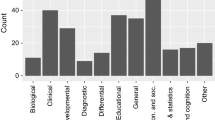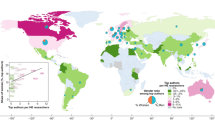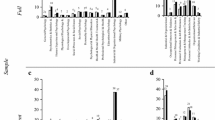Abstract
Gender differences in science and engineering (S&E) have been studied in various countries. Most of these studies find that women are underrepresented in the S&E workforce and publish less than their male peers. The factors that contribute to gender differences in experience and performance in S&E careers can vary from one country to another, yet they remain underexplored. This paper is among the first to systematically compare gender differences in the publication productivity of academic scientists and engineers with doctoral degrees in the U.S. and China. Findings from negative binomial regressions show that women publish less than their male counterparts in science but not in engineering in the U.S. In China, women do not differ from men in publication productivity in science but publish more than their male counterparts in engineering. In addition, we find that some background variables affect men’s and women’s publication productivity differently. The findings are analyzed in the context of the different cultures of the two fields (science vs. engineering) and of the two countries (the U.S. and China). Limitations and policy implications are also discussed.
Similar content being viewed by others
Notes
For instance, agricultural science is an independent field from science (including computer and mathematical, life, and physical sciences) in China, but agricultural science is usually considered as a science in the U.S. In addition, in China, the subfields within agricultural science include statistics, which would be considered as mathematics in the U.S. In this paper, agricultural science in China is grouped into science.
Chinese scientists and engineers also publish in non-SCI journals, mostly in Chinese journals. However, for the purpose of quality control, they are not included in the counts for this study.
Universities overseen by central ministries, such as the Ministry of Education, generally have more research activity than those overseen by provincial or municipal governments.
We performed some preliminary tests to determine whether the zero-inflated negative binomial regression model was better than negative binomial regression because of excessive zeros. Tests failed to show that the zero-inflated negative binomial regression models were better.
Different from the tenure system widely used in the U.S., lifetime employment was adopted by most Chinese universities in 2008. Although Chinese professors also need to publish in international journals to receive promotions and awards, the level of pressure and stress they experience is less than their U.S. counterparts. The promotion system in China is different from that in the U.S. as well, and it usually takes less time for a doctorate recipient to be eligible for promotion review in China than in the U.S. (e.g., in China, a doctorate recipient is eligible for promotion review to the rank of associate professor within 3 years of receiving the doctoral degree, although such review does not guarantee the promotion).
Tables and graphs are available upon request.
Because women doctoral scientists are not similarly disadvantaged, we further run the models within different age groups (below 30, 30-34, 35-39, 40-49, above 50) for scientists and engineers. Both women scientists and engineers have a time period when children have a negative effect on their publication productivity, relative to their male counterparts (or fathers). After that, having children does not have an impact. In the sample of scientists, only 26.4% are in the age range of 35-39, when children have a negative effect on journal publication. In the engineering sample, in contrast, the period susceptible to the effect of children is longer (30-39), and half (51.1%) of the engineers are in this age range. In summary, the different effects of children found in science as opposed to engineering are the result of different age compositions of scientists and engineers in our sample. Therefore, the effect of children on women engineers is not idiosyncratic.
Since a large percentage of Chinese academic scientists and engineers (55.3%), especially the older generation, do not hold a doctoral degree as the highest degree, the Chinese doctoral sample examined here does not represent the whole Chinese science community. We run the same regression models for the Chinese general sample, with education as an additional control variable. Women in the Chinese general sample publish less than their male counterparts in science but not in engineering, similar to the findings in the U.S. sample (doctoral).
References
Aanerud, Rebecca, Emory Morrison, Lori Homer, Elizabeth Rudd, Maresi Nerad, and Joseph Cerny. 2007. Widening the lens on gender and tenure: Looking beyond the academic labor market. NWSA Journal 19(3): 105–123.
Allison, Paul D., and J. Scott Long. 1987. Interuniversity mobility of academic scientists. American Sociological Review 52(5): 643–652.
Allison, Paul D., and J. Scott Long. 1990. Departmental effects on scientific productivity. American Sociological Review 55: 469–478.
Astin, Helen S. 1978. Factors affecting women’s scholarly productivity. In The higher education of women: Essays in honor of Rosemary Park, eds. Helen S. Astin, and Werner Z. Hirsch, 133–157. New York, NY: Praeger.
Astin, Helen S., and Don E. Davis. 1985. Research productivity across the life and career cycles: Facilitators and barriers for women. In Women in higher education: A feminist perspective, eds. Judith Glazer-Raymo, Estela Mara Bensimon, Barbara K. Townsend, 415–423. Needham Heights, MA: ASHE Reader Series, Ginn Press.
Bauer, John, Wang Feng, Nancy E. Riley, and Zhao Xiaohua. 1992. Gender inequality in urban China: Education and employment. Modern China 18: 333–370.
Bernard, Jessie. 1972. The future of marriage. New York: Bantam Books.
Cao, Cong, Ning Li, Xia Li, and Li Liu. 2013. Reforming China’s S&T system. Science 341(6145): 460–462.
Campion, Patricia, and Wesley Shrum. 2004. Gender and science in development: Women scientists in Ghana, Kenya, and India. Science, Technology & Human Values 29(4): 459–485.
Ceci, Stephen J., and Wendy M. Williams. 2011. Understanding current causes of women’s underrepresentation in science. Proceedings of the National Academy of Sciences of the United States of America 108(8): 3157–3162.
Clark, Shirley M., and Mary Corcoran. 1986. Perspectives on the professional socialization of women faculty: A case of accumulative disadvantage? The Journal of Higher Education 57(1): 20–43.
Cole, Jonathan R. 1979. Fair science: Women in the scientific community. New York: Free Press.
Cole, Jonathan R., and Harriet Zuckerman. 1984. The productivity puzzle: Persistence and change in patterns of publication of men and women scientists. In Advances in motivation and achievement, eds. Marjorie W. Steinkempt, and Martin L. Maehr, 217–258. Greenwich: JAI Press.
Cole, Jonathan R., and Harriet Zuckerman. 1987. Marriage, motherhood and research performance in science. Scientific American 256(2): 119–125.
Corley, Elizabeth A. 2005. How do career strategies, gender, and work environment affect faculty productivity levels in university-based science centers? Review of Policy Research 22(5): 637–655.
Corley, Elizabeth A., and Monica Gaughan. 2005. Scientists’ participation in university research centers: What are the gender differences? The Journal of Technology Transfer 30(4): 371–381.
Corley, Elizabeth A., and Meghna Sabharwal. 2007. Foreign-born academic scientists and engineers: Producing more and getting less than their U.S.-born peers? Research in Higher Education 48(8): 909–940.
Ding, Yimin. 2001. In China, publish or perish is becoming the new reality. Science 291(5508): 1477–1479.
Doctorate Recipients’ Occupational Orientation Project Team. 2009. Survey report on doctorate recipients’ occupational orientation. Beijing: China Science and Technology Press.
Etzkowitz, Henry, Carol Kemelgor, and Brian Uzzi. 2000. Athena unbound: The advancement of women in science and technology. Cambridge: Cambridge University Press.
Fox, Mary Frank. 1998. Women in science and engineering: Theory, practice, and policy in programs. Signs 24: 201–223.
Fox, Mary Frank. 2005. Gender, family characteristics, and publication productivity among scientists. Social Studies of Science 35(1): 131–150.
Fox, Mary Frank, and Sushantal Mohapatra. 2007. Social-organizational characteristics of work and publication productivity among academic scientists in doctoral-granting departments. The Journal of Higher Education 78(5): 542–571.
Fox, Mary Frank, Gerhard Sonnert, and Irina Nikiforova. 2009. Successful programs for undergraduate women in science and engineering: Adapting vs. adopting the institutional environment. Research in Higher Education 50: 303–353.
Gao, Ying, and Xiulan Zhang. 2011. Marital status in recent years: The case of Beijing. The Chinese Journal of Population Science 6: 60–71.
Gereffi, Gary, Vivek Wadhwa, Ben Rissing, and Ryan Ong. 2008. Getting the numbers right: International engineering education in the United States, China, and India. Journal of Engineering Education 97(1): 13–25.
Ginther, Donna K., and Kathy J. Hayes. 2003. Gender differences in salary and promotion for faculty in the humanities 1977–95. Journal of Human Resources 38(1): 34–73.
Hargens, Lowell L., and Warren O. Hagstrom. 1967. Sponsored and contest mobility of American academic scientists. Sociology of Education 40(1): 24–38.
Hargens, Lowell L., and J. Scott Long. 2002. Demographic inertia and women’s representation among faculty in higher education. The Journal of Higher Education 73(4): 494–517.
Hong, Wei, and Yandong Zhao. 2016. How social networks affect scientific performance: Evidence from a national survey of Chinese scientists. Science, Technology, & Human Values 41(2): 243–273.
Hunt, Jennifer, Jeanphilippe Garant, Hannah Herman, and David J. Munroe. 2013. Why are women underrepresented amongst patentees? Research Policy 42(4): 831–843.
Hvistendahl, Mara. 2011. China looks to purge academia of ‘trash journals’. Science 334(6054): 301.
Jin, Bi. 1997. A survey and analysis of female awardees in China. Democracy and Science 6: 11–13.
Jung, Jisun. 2012. Faculty research productivity in Hong Kong across academic discipline. Higher Education Studies 2(4): 1–13.
Kim, Dongbin, Lisa Wolf-Wendel, and Susan Twombly. 2011. International faculty: Experiences of academic life and productivity in U.S. universities. The Journal of Higher Education 82(6): 720–747.
Lariviere, Vincent, Chaoqun Ni, Yves Gingras, Blaise Cronin, and Cassidy R. Sugimoto. 2013. Bibliometrics: Global gender disparities in science. Nature 504: 211–213.
Levin, Sharon G., and Paula E. Stephan. 1991. Research productivity over the life cycle: Evidence for academic scientists. The American Economic Review 81(1): 114–132.
Lin, Juren. 2000. On the sex differentiation and sex segregation in China’s S&T circles. Studies in Science of Science 18(1): 97–112.
Liu, Wanhua, Ruhai Yuan, Zhaohong Pei, and Xueni Gan. 2004. International comparison and thought of faculty salary. Journal of Tsinghua University (Philosophy and Social Sciences) 19(6): 86–92.
Liu, Xielin, and Tingting Zhi. 2010. China is catching up in science and innovation: The experience of the Chinese Academy of Sciences. Science and Public Policy 37(5): 331–342.
Long, J. Scott. 1978. Productivity and academic position in the scientific career. American Sociological Review 43(6): 889–908.
Long, J. Scott. 1990. The origins of sex differences in science. Social Forces 68(4): 1297–1316.
Long, J. Scott. 1992. Measures of sex differences in scientific productivity. Social Forces 71(1): 159–178.
Long, J. Scott, and Mary Frank Fox. 1995. Scientific careers: Universalism and particularism. Annual Review of Sociology 21: 45–71.
Long, J. Scott, Paul D. Allison, and Robert McGinnis. 1993. Rank advancement in academic careers: Sex differences and the effects of productivity. American Sociological Review 58(5): 703–722.
Long, J. Scott, and Robert McGinnis. 1981. Organizational context and scientific productivity. American Sociological Review 46(4): 422–442.
Luo, Lin. 1990. Salaries of faculty members: Situation, impact, origin, and policy implications. Research in Higher Education 39: 73–79.
Ma, Ying. 2009. Gender differences and occupational accomplishment among doctorate graduates. Collection of Women’s Studies 2009(6): 38–42.
Mason, Mary Ann, Marc Goulden, and Karie Frasch. 2009. Why graduate students reject the fast track. Academe 95(1): 11–16.
Mason, Mary Ann, Nicolas H. Wolfinger, and Marc Goulden. 2013. Do babies matter? Gender and family in the ivory tower. New Brunswick, NJ: Rutgers University Press.
Mellström, Ulf. 2009. The intersection of gender, race and cultural boundaries, or why is computer science in Malaysia dominated by women? Social Studies of Science 39(6): 885–907.
Merton, Robert K. 1973. The sociology of science. Chicago: University of Chicago Press.
Miller, B. Paige, Ricardo Duque, and Wesley Shrum. 2012. Gender, ICTs, and productivity in low-income countries: A panel study. Science, Technology, & Human Values 37(1): 30–63.
Miller, H. Lyman. 1996. Science and dissent in post-Mao China: The politics of knowledge. Seattle: University of Washington Press.
MIT Report. 1999. A study on the status of women faculty in science at MIT. http://web.mit.edu/fnl/women/women.html. Accessed 19 January 2009.
MIT Report. 2002. The status of women faculty at MIT: An overview of reports from the schools of architecture and planning; engineering; humanities, arts, and social sciences; and the Sloan school of management. http://web.mit.edu/faculty/reports/pdf/overview.pdf. Accessed 19 January 2009.
MIT Report. 2011. A report on the status of women faculty in the schools of science and engineering at MIT. http://web.mit.edu/newsoffice/images/documents/women-report-2011.pdf. Accessed 30 November 2013.
Mozaffarian, Mehrnoush, and Hamid R. Jamali. 2008. Iranian women in science: A gender study of scientific productivity in an Islamic country. Aslib Journal of Information Management 60(5): 463–473.
National Science Foundation, Division of Science Resources Statistics. 2003. Gender differences in the careers of academic scientists and engineers: A literature review, NSF 03-322, Project Director, Alan I. Rapoport (Arlington, VA).
Population Research Center of the Chinese Academy of Social Sciences. 1986. Almanac of China’s population. Beijing: Social Sciences Academic Press.
Primack, Richard B., and Virginia E. Oleary. 1993. Cumulative disadvantages in the careers of women ecologists. BioScience 43(3): 158–165.
Prozesky, Heidi. 2008. A career-history analysis of gender differences in publication productivity among South African academics. Science Studies 21(2): 47–67.
Rawski, Evelyn. 1979. Education and popular literacy in Ch’ing China. Ann Arbor: University of Michigan Press.
Reskin, Barbara F. 1977. Scientific productivity and the reward structure of science. American Sociological Review 42(3): 491–504.
Reskin, Barbara F. 1978. Sex differentiation and the social organization of science. Sociological Inquiry 48: 6–36.
Sabharwal, Meghna. 2013. Comparing research productivity across disciplines and career stages. Journal of Comparative Policy Analysis: Research and Practice 15(2): 141–163.
Sabharwal, Meghna, and Elizabeth A. Corley. 2008. Categorization of minority groups in academic science and engineering. Journal of Women and Minorities in Science and Engineering 14(4): 427–446.
Shen, Helen. 2013. Inequality quantified: Mind the gender gap. Nature 495: 22–24.
Shin, Jung Cheol, Jisun Jung, Gerard A. Postiglione, and Norzaini Azman. 2014. Research Productivity of Returnees from Study Abroad in Korea, Hong Kong, and Malaysia. Minerva 52(4): 467–487.
Shu, Xiaoling. 2004. Education and gender egalitarianism: The case of China. Sociology of Education 77(4): 311–336.
Sonnert, Gerhard, and Gerald Holton. 1995. Who succeeds in science: The gender dimension. New Brunswick, N.J.: Rutgers University Press.
Sotudeh, Hajar, and Nahid Khoshian. 2014. Gender differences in science: The case of scientific productivity in Nano Science & Technology during 2005–2007. Scientometrics 98(1): 457–472.
Stack, Steven. 2004. Gender, children and research productivity. Research in Higher Education 45(8): 891–920.
Stephan, Paula E., and Sharon G. Levin. 1991. Inequality in scientific performance: Adjustment for attribution and journal impact. Social Studies of Science 21(2): 351–368.
Stone, Richard. 2011. China bets big on small grants, large facilities. Science 331(6022): 1251.
Sun, Yutao, and Cong Cao. 2014. Demystifying central government R&D spending in China: Should funding focus on scientific research? Science 345(6200): 1006–1008.
Tao, Yu. 2016. Where do they do engineering? Gender differences in employment sectors and types of positions among engineering doctorate recipients. Journal of Women and Minorities in Science and Engineering 22(1): 69–89.
Tsui, Ming, and Lynne Rich. 2002. The Only Child and Educational Opportunity for Girls in Urban China. Gender and Society 16(1): 74–92.
Turner, Caroline, Samuel L. Myers, and John W. Creswell. 1999. Exploring underrepresentation: The case of faculty of color in the Midwest. Journal of Higher Education 70(1): 27–59.
U.S. National Research Council. 2010. Gender differences at critical transitions in the careers of science, engineering, and mathematics faculty. Washington, D.C.: The National Academies Press.
U.S. National Science Board. 2014. Science and engineering indicators. Arlington VA: National Science Foundation.
Whittington, Kjersten Bunker, and Laurel Smith-Doerr. 2008. Women inventors in context: Disparities in patenting across academia and industry. Gender & Society 22(2): 194–218.
Wu, Lilian, and Wei Jing. 2011. Asian women in STEM careers: An invisible minority in a double bind. Issues in Science and Technology 28(1): 82–87.
Xie, Yu, and Alexandra Killewald. 2012. Is American science in decline? Cambridge, MA: Harvard University Press.
Xie, Yu, and Kimberlee A. Shauman. 1998. Sex differences in research productivity: New evidence about an old puzzle. American Sociological Review 63: 847–870.
Xie, Yu, and Kimberlee A. Shauman. 2003. Women in science: Career processes and outcomes. Cambridge, MA: Harvard University Press.
Xie, Yu. 2014. Inequality in science. Science 344(6186): 809–810.
Xin, Hao. 2006. Scandals shake Chinese science. Science 312: 1464–1466.
Yang, Wei. 2013. Research integrity in China. Science 342: 1019.
Zhang, Cuixia, and John E. Farley. 1995. Gender and distribution of household work: A comparison of self-reports by female college faculty in the United States and China. Journal of Comparative Family Studies 26: 195–205.
Zhao, Lanxiang, and Lexuan Li. 2008. The influence of female subjective value priority on the gender stratification of Chinese science community. Studies in Science of Science 26(6): 1157–1163.
Zhu, Chuzhu, and Xiao Guang. 1991. An analysis of the life cycle of Chinese women. Chinese Journal of Population Science 3: 247–257.
Zhu, Yina, and Yangxu Lu. 2014. Gender, family, and time allocation among Chinese university faculty: Based on 2011 time use study among Chinese academic and research professionals. Collection of Women’s Studies 5: 24–32.
Zuckerman, Harriet. 1991. The careers of men and women scientists: A review of current research. In The outer circle: Women in the scientific community, eds. John T. Bruer, Jonathan R. Cole, and Harriet Zuckerman, 27–56. New York: W.W. Norton & Company.
Zuckerman, Harriet, and Jonathan R. Cole. 1975. Women in American science. Minerva 13(1): 82–102.
Acknowledgments
Funding was provided by Tsinghua University Initiative Scientific Research Program (Grant Nos. 20131089330, 20141081191), Chinese Association of Science and Technology (Grant No. 2008DCYJ01).
Author information
Authors and Affiliations
Corresponding author
Rights and permissions
About this article
Cite this article
Tao, Y., Hong, W. & Ma, Y. Gender Differences in Publication Productivity Among Academic Scientists and Engineers in the U.S. and China: Similarities and Differences. Minerva 55, 459–484 (2017). https://doi.org/10.1007/s11024-017-9320-6
Published:
Issue Date:
DOI: https://doi.org/10.1007/s11024-017-9320-6




